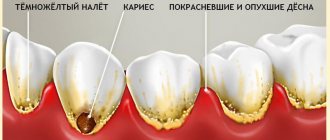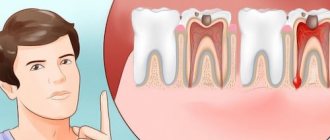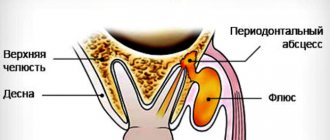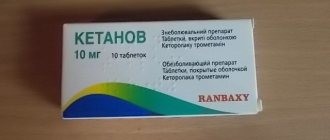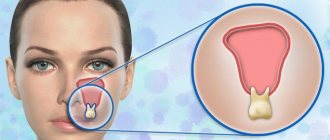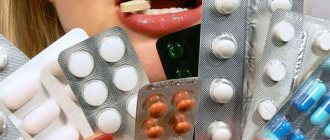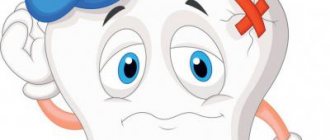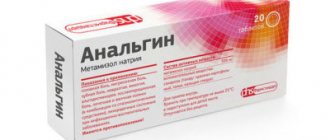Tablets for toothache relief
Review of painkillers
Disadvantages of tablets
Painkillers for pregnant and nursing mothers
What not to do if your tooth suddenly hurts
In most cases, the first thing people do when pain occurs is take pills. This is the most common and accessible way to get rid of unpleasant sensations. Of course, the ideal solution would be to see a doctor, but there are different situations: there is no time, clinics are closed (tooth pain at night), financial situation, etc. We provide a list of the most effective remedies for toothache and we hope that you will use them only as a last resort case.
Infiltration anesthesia
Classic “freezing”, which is used in dentistry for almost any manipulation. The drug is injected under the mucosa, into the periosteum or directly into the bone. Depending on the procedure and the patient’s pain threshold, the required dosage is selected - for example, in case of acute pulpitis or complex tooth extraction, a higher concentration of the drug is used. If the patient is afraid of injections, topical anesthesia can additionally be used to numb the site of needle insertion, or xenon sedation.
When performing the procedure, the doctor must take into account the anatomy of the jaw system. For example, in the lower jaw the alveolar bone is denser, so anesthesia is less effective. In the upper jaw, when performing manipulations in the area of wisdom teeth, there is a risk of the needle touching one of the branches of the facial nerve, which is fraught with the development of neuralgia. The clinic’s doctors have the necessary qualifications, so even the most complex anesthesia is performed completely safely for the patient.
Review of painkillers
Table 1. Painkillers
| Drug name | Appearance | Characteristics and action |
| Nimesil | Available in the form of tablets, granules, suspensions. Recommended for mild to moderate toothache. | |
| Nise | Available in various forms. Suitable for mild to moderate pain. | |
| Ketorol | Available in the form of tablets and capsules for injection. Will help relieve moderate to severe pain. Maximum dose per day – 3 tablets | |
| Ibuklin | Available in tablet form. Recommended for mild to moderate pain. | |
| Tempalgin | Has anti-inflammatory and antipyretic effects. Does not irritate the gastric mucosa. | |
| Nurofen | Available in the form of tablets, suspension and gel (for external use). | |
| Took | Available in tablet form. Helps relieve moderate toothache. | |
| Analgin | Available in various forms. The maximum dose per day is 4 tablets. |
“Remember that the pill is a temporary way to relieve pain.
The effect of the drug will wear off, and the pain may return because the cause itself has not been eliminated. If after the first “bells” you do not go to the dentist, the disease will continue to progress. Each time the pain will get stronger and stronger" Irina Vinogradova, Dentist-therapist, endodontist, head of the department of therapy and periodontology, member of the medical council of the network of clinics "STOMPRAKTIKA.RF"
Description of the drug and mechanism of action
The active analgesic substance in analgin is metamizole sodium, which reduces fever, blocks pain and stops the development of the inflammatory process. However, the effect of metamizole sodium eliminates the pain symptom not completely, but only partially. The feeling of pain remains, although not pronounced. Therefore, the use of analgin is justified if the pain is not acute. Any medicine based on metamizole sodium cannot cope with severe pain.
What is the mechanism of action of the drug based on? The treatment formula aims to suppress and block prostaglandins, which are responsible for the sensation of pain in the body. Prostaglandins are active substances that provoke the development of inflammatory processes in tissues damaged by bacteria and are responsible for transmitting pain impulses to the brain. Since the main effect of analgin is aimed at reducing heat in the body, it cannot completely relieve pain.
Also, analgin will not be able to block the development of the inflammatory process in the periosteum, gum or pulp due to its low effectiveness in this direction. Other medications are used to block inflammatory processes. Do not forget that this drug is mainly taken for colds and diseases with the presence of hyperthermia.
Disadvantages of tablets
Painkillers also have a downside: almost all pills have side effects.
- Negatively affect the functioning of the digestive system. Erosion and ulcers can form on the walls of the stomach, so if there are problems with the gastrointestinal tract, it is better to choose a different method.
- Disturbs liver function.
- They can cause headache, shortness of breath, swelling, skin rashes, etc.
Most analgesics are prohibited for expectant and nursing mothers, young children and people with systemic diseases that are included in the list of contraindications. Therefore, it is recommended to consult a doctor before use.
No pain – anesthesia in modern dentistry
General dentist Lelekov Alexander Mikhailovich tells.
Dentists don't like to hurt. Civilized dentistry strives for complete painlessness at all stages of treatment.
The most unpleasant procedures, such as treatment of deep caries and pulpitis, tooth extraction, are unthinkable without effective anesthesia.
There are many everyday myths and outdated ideas associated with anesthesia. I’ll tell you more about this useful tool, which makes treatment comfortable, without suffering, pain and tears.
Why is it painful to be treated in some clinics, but not in others?
The patient’s sensations depend on many factors, but the most important is the anesthetic drug itself. At the beginning of the twentieth century, dentists began to use novocaine, and from the middle of the century - the more powerful lidocaine. At one time, this was a real breakthrough in medicine. The treatment became tolerable, but the pain could not be completely eliminated.
Modern clinics use anesthetics based on articaine.
Before treatment, be sure to ask what drug is used to relieve pain:
- Based on articaine, it shouldn’t hurt.
- Lidocaine, novocaine - most likely get ready for a test of patience.
For comfortable and safe treatment of my patients, I use:
- Articaine Inibsa (Spain),
- Ultracaine Sanofi (France),
- Scandonest Septodont (France).
I use Articaine in most situations. Ultracaine D, Scandonest, which do not contain adrenaline - if the patient has health problems. They can be used in elderly people, patients with diabetes mellitus, hypertension, cardiovascular diseases, and bronchial asthma. The listed anesthetics do not penetrate the placental barrier and are approved for pregnant women.
Do anesthetics contain adrenaline?
Many patients are afraid that they will be injected with adrenaline along with the anesthetic. Adrenaline (epinephrine), indeed, is contained in anesthetics; dentists value it for its vasoconstrictor effect:
- The removal of anesthetic from tissues is slowed down, so the anesthesia lasts longer.
- Bleeding is reduced, which is important when removing a tooth, treating gums or caries in the gingival area of the tooth.
But there are also undesirable effects: adrenaline can increase your heart rate and increase your blood pressure. A healthy person, as a rule, does not even notice this. But for children and patients with cardiovascular diseases, drugs with adrenaline are contraindicated.
They are given an anesthetic with reduced or no adrenaline. Earlier I mentioned the drugs Scandonest and Ultracain D - they do not contain adrenaline at all.
A mosquito is about to bite
Whether the injection will be unpleasant depends on several factors:
- Which tooth are we treating: anesthesia can be very sensitive when placed in the area of the upper and lower incisors. Mandibular anesthesia is unpleasant: an injection into the area of the mandibular nerve.
- Doctor's manual skills. If the doctor has “trained his hand” properly, is not in a hurry and has set himself the goal of making the treatment as pleasant as possible for the patient, then the injection may not be felt at all.
- The equipment of the clinic: for the patient’s comfort, thin needles and special carpule syringes were invented. For children, topical anesthesia is used - the gel is applied to the gum and “freezes” it before the injection.
Carpule syringe
You may have noticed the unusual but recognizable shape of an anesthesia syringe. It has rings on the sides to make it fit more comfortably in the doctor's hand.
But the main thing about it is a mechanism that allows you to carry out anesthesia quickly, effectively and safely in absolutely sterile conditions. The capsule with the drug is opened by this mechanism right inside the syringe. Fewer hands means fewer germs.
The needles for the carpule syringe are thin and flexible, they are easy to bend at the desired angle. With them you can get close to awkwardly located teeth and provide pain relief in the best possible way.
If anesthesia is contraindicated
In most cases, anesthesia is not completely contraindicated, but only requires a more careful, balanced approach. The doctor takes into account the patient’s age, health characteristics and selects the optimal drug and dosage.
Be sure to tell your doctor if you have the following diseases:
- Heart diseases: arrhythmia and tachycardia, previous heart attacks and heart surgery.
- High blood pressure.
- Problems with the endocrine system: diabetes and thyroid lesions.
- Glaucoma.
- Liver failure.
- Psychoneurological diseases, including epilepsy.
- Individual intolerance to the components of the drug.
Allergy to local anesthetics deserves special attention. If you have ever had an allergic reaction to an anesthetic, be sure to remember its name.
In diagnostic laboratories you can order an allergy panel - an analysis of the body's reactions to various drugs. This way you will find the anesthetic approved for you. There is no need to buy it or bring it to your appointment! When making an appointment with a dentist or for a consultation, check whether the clinic can purchase the required anesthetic for you.
General anesthesia
If it is impossible to use any local anesthetic, we will not torment the patient with pain anyway. In such cases, anesthesia is used - dental treatment during sleep.
The procedure is carried out under the supervision of an anesthesiologist-resuscitator, who monitors the patient’s condition using special equipment.
To make the anesthesia work better
A few tips for maximum pain relief:
- Don’t be nervous before your appointment; you can take a mild sedative;
- Do not drink alcohol or liters of coffee, they can reduce the effectiveness of anesthesia;
- Don't delay treatment. If pus forms near the tooth, it will prevent the anesthetic from working.
High-quality anesthesia is not only about the comfort and peace of mind of the doctor and the patient.
Most patients who are afraid of dental treatment are actually afraid of the pain, not the treatment itself. And the fear goes away when they come to the clinic, where reliable pain relief is used.
Having got used to good anesthesia, the patient does not delay treatment and keeps his teeth healthy!
Symptoms of acute pulpitis
As the disease develops, aching pain in the tooth first appears, which has an increasing character. The pain syndrome is constant or intermittent, significantly intensifies at night and with temperature influences. A diseased tooth reacts most strongly to cold. If you knock on the surface, the patient does not have any unpleasant sensations or they are insignificant.
The manifestations of symptoms of acute pulpitis depend on its form.
Hyperemia
It develops as a result of the activity of pathogenic bacteria that enter the dental tissue during untreated caries. It can occur during tooth preparation or after it has been treated with chemicals.
With hyperemia, the patient is concerned about the following symptoms:
- It's a dull pain. Occurs as a reaction to stimuli. Mostly, the painful attack does not last long, about 2 – 3 minutes, and at night lingering pain develops. In the case of an advanced form, the pain is felt as sharp and strong lumbago.
- Severe pain reaction when enamel is exposed to cold.
Acute focal
Signs that indicate the development of this form of pulpitis:
- Painful attacks occur spontaneously.
- They last for at least 30 minutes; in advanced stages they can last up to two hours.
- A carious cavity is revealed, which is painful during examination.
In acute focal pulpitis, the pain does not radiate to adjacent teeth.
Acute diffuse
It develops as a consequence of an advanced focal form and the lack of timely treatment.
Characterized by the following symptoms:
- The pain syndrome occurs spontaneously and suddenly, without exposure to any irritants. The pain is prolonged, does not go away for many hours, and radiates to nearby teeth.
- The presence of a carious cavity, when examined, a sharp painful reaction occurs. Remnants of filling material may remain.
Acute purulent
If the acute diffuse form is not treated, it gradually turns into a purulent form. Characteristic symptoms:
- The pain attack is cutting, acute in nature. The pain is constant and may periodically weaken or intensify.
- The pain radiates to neighboring teeth, as well as along the branches of the trigeminal nerve.
- When exposed to heat, the pain becomes stronger; when applying a cold compress, it subsides a little.
- Pus accumulates in the tooth cavity and can be detected by microscopic examination.
- The soft tissues melt and abscesses with pus form in them.
- The blood vessels are dilated and have many microdamages.
Traumatic acute
Develops as a result of tooth injury due to improper preparation of a carious cavity, chipping of a dental crown or fracture.
This form of pulpitis is characterized by the following symptoms:
- The pulp horn bleeds, which is noticeable during a dental examination.
- The dental cavity communicates pointwise with the carious cavity.
- In the pulp tissues, a bundle of vessels and nerves is exposed.
If there are signs indicating acute pulpitis of the tooth, treatment should not be delayed. A timely visit to the clinic will help save the tooth.
How to cope with pain after dental treatment?
To feel comfortable after dental treatment, you must first take proper care of your oral cavity. The dentist must tell the patient in detail exactly how to carry out daily hygienic care of teeth and gums. After installing a filling or cleaning the canals, it is important not to put heavy stress on the treated tooth for some time. The following methods are also effective:
- Cold compress . Exposure to cold is good for eliminating swelling and dulling pain after invasive dental procedures. On the first day after treatment, you can apply cold compresses to the cheek in the area of pain. In order not to overcool the tissues, it is important to take a short break every 10-15 minutes.
- Baths with antiseptics or medicinal herbs . In some cases, it is recommended to take baths with antiseptic solutions several times a day to prevent infection and relieve pain.
- Taking medications . To improve your well-being in the first few days after dental treatment, you can take non-steroidal anti-inflammatory drugs that quickly and effectively relieve pain, swelling and other unpleasant symptoms. A safe remedy must be recommended by a doctor. Antibiotics after dental treatment are also prescribed exclusively by the attending physician.
If you follow all the doctor’s recommendations, the pain after tooth treatment will gradually decrease and completely disappear after a few days.

